人教版(2019)必修第二册:Unit 2 Wildlife protection Listening and Talking练习(含答案)
文档属性
| 名称 | 人教版(2019)必修第二册:Unit 2 Wildlife protection Listening and Talking练习(含答案) | 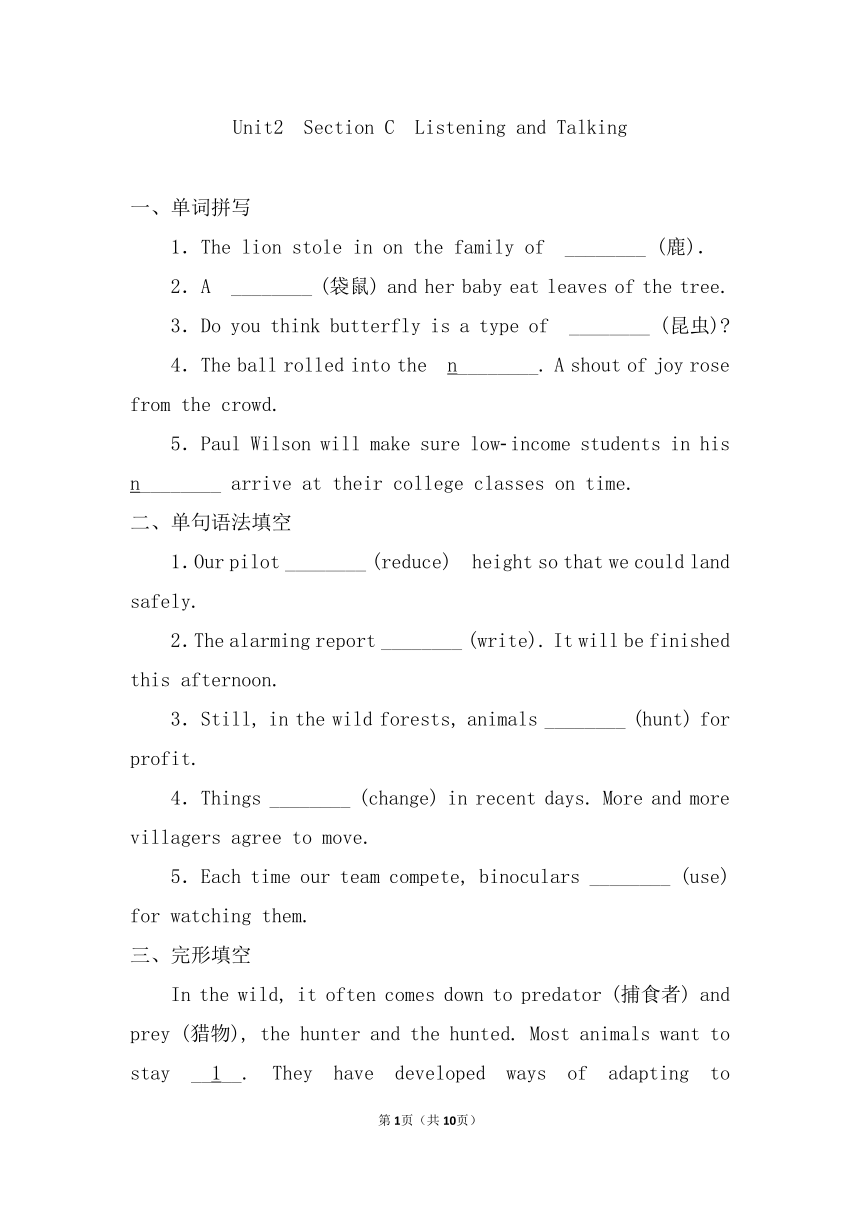 | |
| 格式 | doc | ||
| 文件大小 | 294.5KB | ||
| 资源类型 | 教案 | ||
| 版本资源 | 人教版(2019) | ||
| 科目 | 英语 | ||
| 更新时间 | 2021-11-04 16:58:56 | ||
图片预览

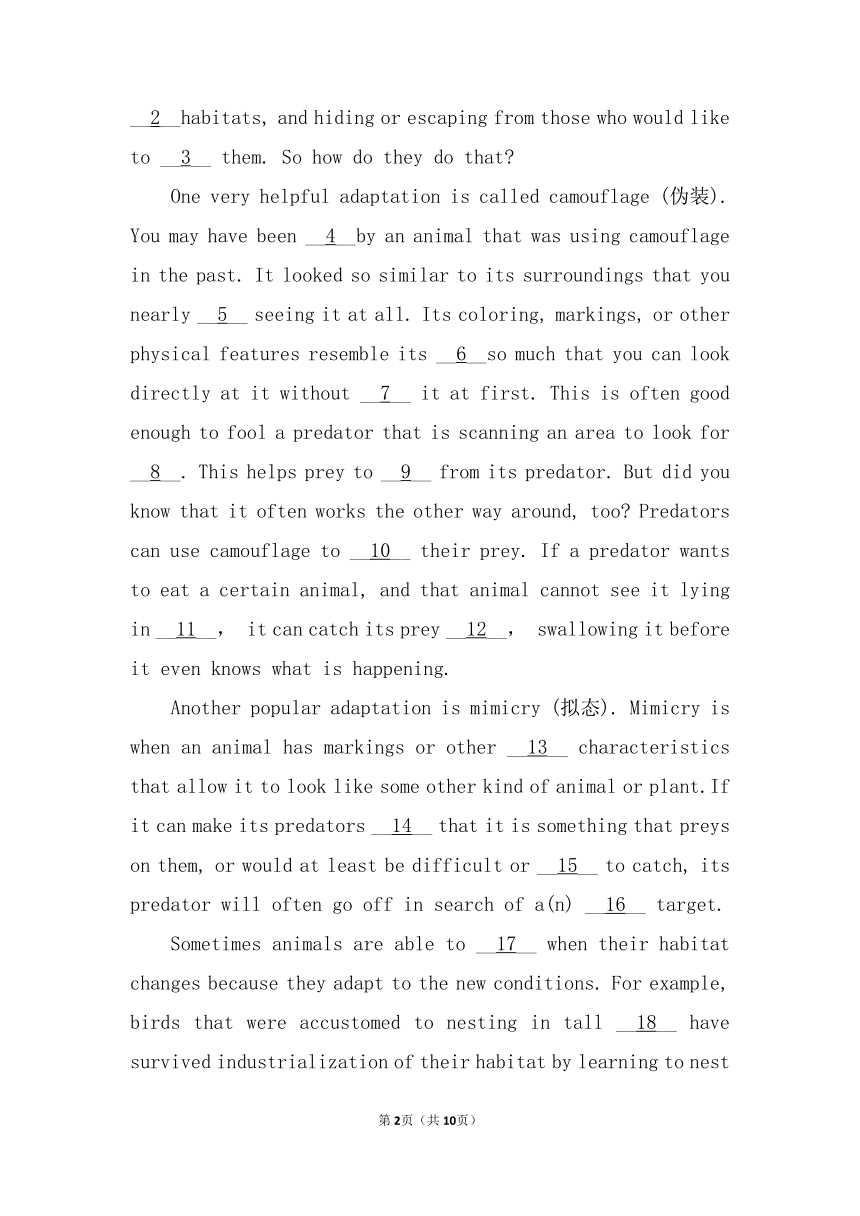
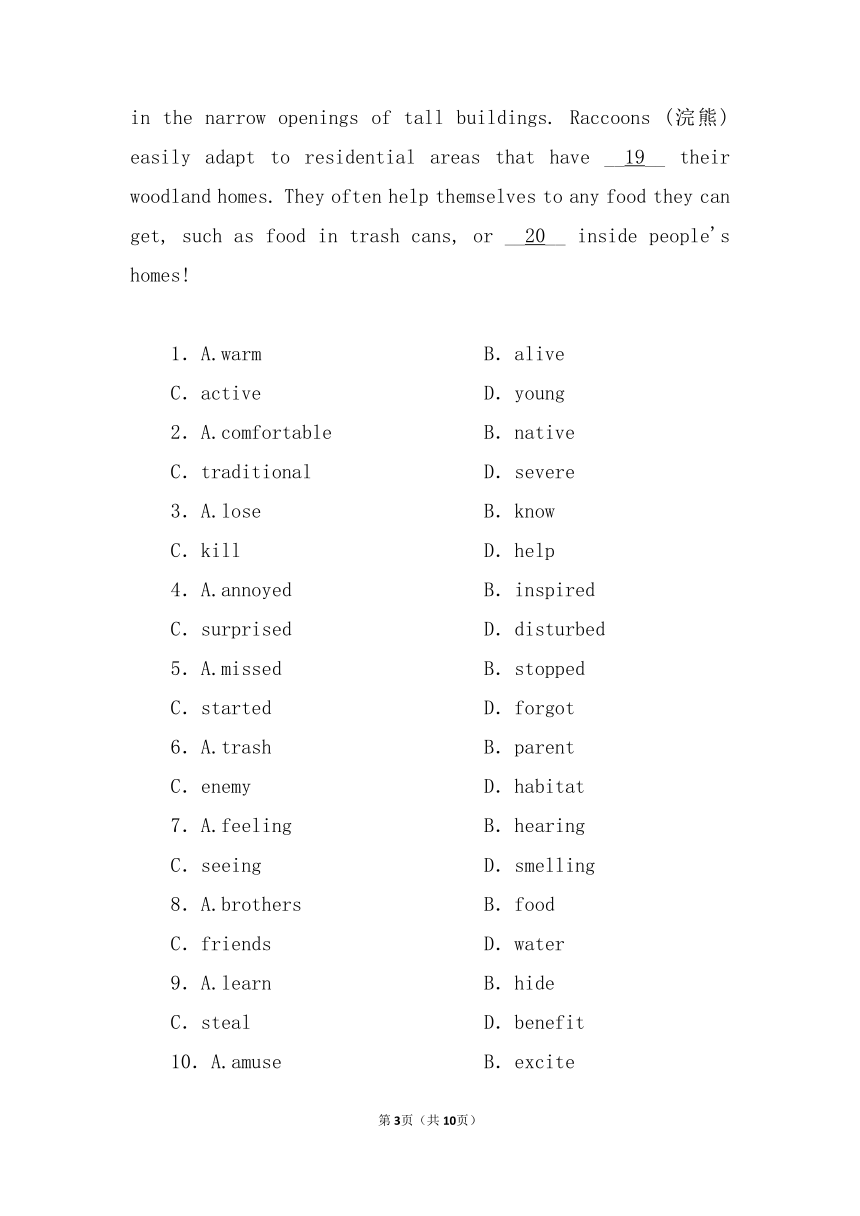
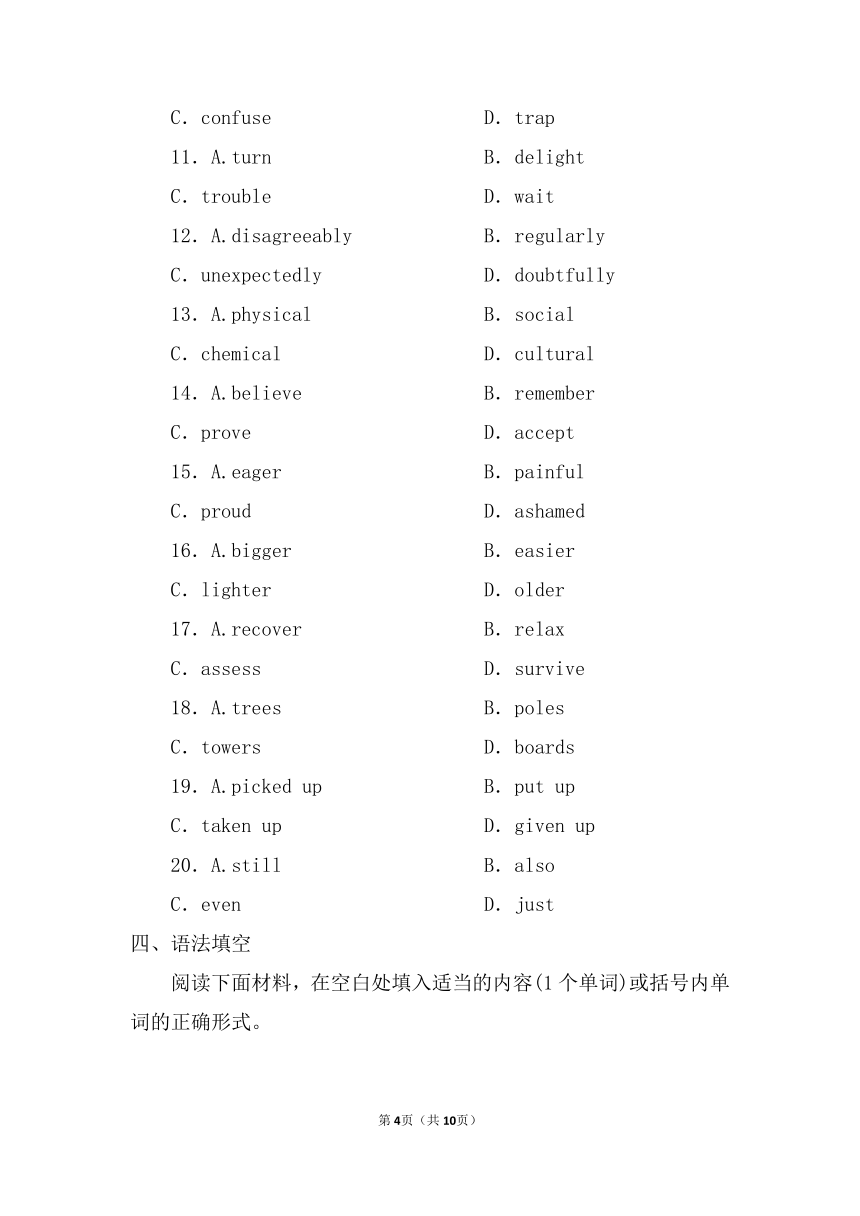
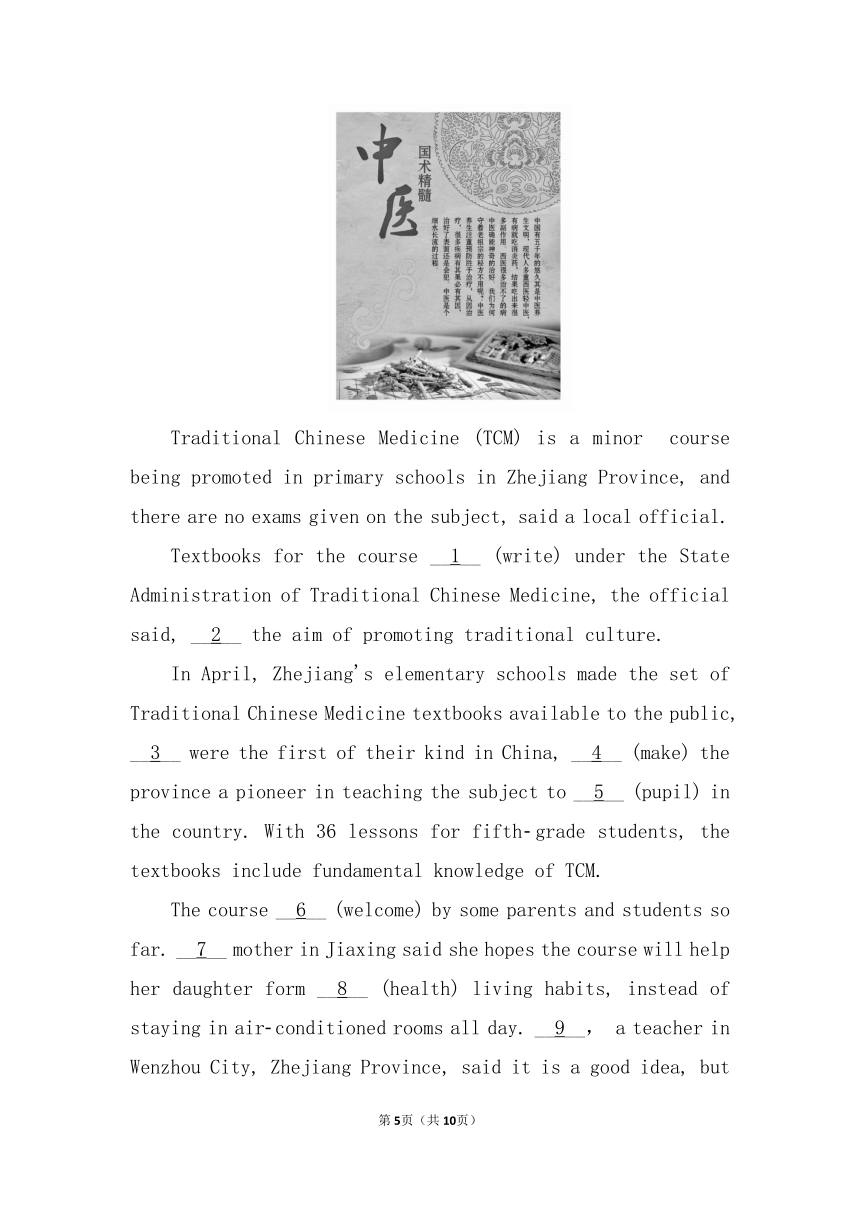
文档简介
Unit2 Section C Listening and Talking
一、单词拼写
1.The lion stole in on the family of ________ (鹿).
2.A ________ (袋鼠) and her baby eat leaves of the tree.
3.Do you think butterfly is a type of ________ (昆虫)
4.The ball rolled into the n________. A shout of joy rose from the crowd.
5.Paul Wilson will make sure low income students in his n________ arrive at their college classes on time.
二、单句语法填空
1.Our pilot ________ (reduce) height so that we could land safely.
2.The alarming report ________ (write). It will be finished this afternoon.
3.Still, in the wild forests, animals ________ (hunt) for profit.
4.Things ________ (change) in recent days. More and more villagers agree to move.
5.Each time our team compete, binoculars ________ (use) for watching them.
三、完形填空
In the wild, it often comes down to predator (捕食者) and prey (猎物), the hunter and the hunted. Most animals want to stay __1__. They have developed ways of adapting to __2__habitats, and hiding or escaping from those who would like to __3__ them. So how do they do that
One very helpful adaptation is called camouflage (伪装). You may have been __4__by an animal that was using camouflage in the past. It looked so similar to its surroundings that you nearly __5__ seeing it at all. Its coloring, markings, or other physical features resemble its __6__so much that you can look directly at it without __7__ it at first. This is often good enough to fool a predator that is scanning an area to look for __8__. This helps prey to __9__ from its predator. But did you know that it often works the other way around, too Predators can use camouflage to __10__ their prey. If a predator wants to eat a certain animal, and that animal cannot see it lying in __11__, it can catch its prey __12__, swallowing it before it even knows what is happening.
Another popular adaptation is mimicry (拟态). Mimicry is when an animal has markings or other __13__ characteristics that allow it to look like some other kind of animal or plant.If it can make its predators __14__ that it is something that preys on them, or would at least be difficult or __15__ to catch, its predator will often go off in search of a(n) __16__ target.
Sometimes animals are able to __17__ when their habitat changes because they adapt to the new conditions. For example, birds that were accustomed to nesting in tall __18__ have survived industrialization of their habitat by learning to nest in the narrow openings of tall buildings. Raccoons (浣熊) easily adapt to residential areas that have __19__ their woodland homes. They often help themselves to any food they can get, such as food in trash cans, or __20__ inside people's homes!
1.A.warm B.alive
C.active D.young
2.A.comfortable B.native
C.traditional D.severe
3.A.lose B.know
C.kill D.help
4.A.annoyed B.inspired
C.surprised D.disturbed
5.A.missed B.stopped
C.started D.forgot
6.A.trash B.parent
C.enemy D.habitat
7.A.feeling B.hearing
C.seeing D.smelling
8.A.brothers B.food
C.friends D.water
9.A.learn B.hide
C.steal D.benefit
10.A.amuse B.excite
C.confuse D.trap
11.A.turn B.delight
C.trouble D.wait
12.A.disagreeably B.regularly
C.unexpectedly D.doubtfully
13.A.physical B.social
C.chemical D.cultural
14.A.believe B.remember
C.prove D.accept
15.A.eager B.painful
C.proud D.ashamed
16.A.bigger B.easier
C.lighter D.older
17.A.recover B.relax
C.assess D.survive
18.A.trees B.poles
C.towers D.boards
19.A.picked up B.put up
C.taken up D.given up
20.A.still B.also
C.even D.just
四、语法填空
阅读下面材料,在空白处填入适当的内容(1个单词)或括号内单词的正确形式。
Traditional Chinese Medicine (TCM) is a minor course being promoted in primary schools in Zhejiang Province, and there are no exams given on the subject, said a local official.
Textbooks for the course __1__ (write) under the State Administration of Traditional Chinese Medicine, the official said, __2__ the aim of promoting traditional culture.
In April, Zhejiang's elementary schools made the set of Traditional Chinese Medicine textbooks available to the public, __3__ were the first of their kind in China, __4__ (make) the province a pioneer in teaching the subject to __5__ (pupil) in the country. With 36 lessons for fifth grade students, the textbooks include fundamental knowledge of TCM.
The course __6__ (welcome) by some parents and students so far. __7__ mother in Jiaxing said she hopes the course will help her daughter form __8__ (health) living habits, instead of staying in air conditioned rooms all day. __9__, a teacher in Wenzhou City, Zhejiang Province, said it is a good idea, but that some schools lack specialized (专门的) teachers. Elementary schools in Wenzhou are looking for good teachers and preparing __10__ (start) the lessons soon, Chinese media said.
一、单词拼写
1.deer
2.kangaroo
3.insect
4.net
5.neighbourhood
二、单句语法填空
1.reduced
2.is being written
3.are being hunted
4.have changed
5.are used
三、完形填空
1.B 由上文的“the hunter and the hunted”及下文的“hiding or escaping from”可推断,大多数动物想要“活着(alive)”。
2.D 由上文的“have developed ways of adapting”可推断,动物们用各种方法适应“严峻的(severe)”自然环境。
3.C 动物们总是逃避想要“杀死(kill)”它们的天敌。
4.C 由下文的“ ... that was using camouflage in the past. It looked so similar to its surroundings ...”可推断,或许有一只伪装在与其看起来很像的环境中的动物曾“使你感到惊讶(surprised)”。
5.A 由上文的“It looked so similar to its surroundings ...”可知,伪装的动物与其所处的环境很相似,以至于你差点“没有(missed)”看到它。
6.D 由第5空前的surroundings可知此处也指类似含义,结合选项可知“habitat (栖息地)”也表动物所处的环境。
7.C 伪装的动物的外表和其所处的周边环境如此相似以至于你可能盯着它(所处的位置)却没能一开始就“看到(seeing)”它。
8.B 伪装可以欺骗正在寻找“食物(food)”的捕食者。
9.B 伪装可以帮助猎物“躲避(hide)”它的捕食者。
10.D 由上文的“... it often works the other way around ...”可知,不光猎物会通过伪装躲避捕食者,捕食者也会通过伪装给猎物“设陷阱捕捉(trap)”。
11.D 动物无法发现正在伪装、“埋伏着等待(lie in wait)”的捕食者。
12.C 正在伪装的捕食者因为不易被发现,所以可以“出乎意料地(unexpectedly)”抓住它的猎物。
13.A 由下文的“... allow it to look like some other kind of animal or plant”可知,拟态是指一些动物的“身体(physical)”特征使其看起来像其他的动物或植物。
14.A 由下文的“its predator will often go off”可推断,拟态的动物会尽力使它的捕食者“认为(believe)”它是有危险性的。
15.B 由上文的“... preys on them, or would at least be difficult ...”可知,此处应选与difficult近义的词,即拟态的动物会使其捕食者认为抓它至少是“棘手的(painful)”事情。
16.B 捕食者常常避开拟态的动物,去寻找“较容易的(easier)”目标。
17.D 由下文的“... they adapt to the new conditions”可推断,有时动物能通过适应新的环境,在变化中的栖息地中“幸存下来(survive)”。
18.A 由下文的“... have survived industrialization of their habitat ...”可推断,鸟类过去习惯于在高大的“树木(trees)”上筑巢。
19.C 浣熊很容易地适应“占据了(taken up)”它们林地家园的居民区。
20.C 浣熊会吃它们能得到的任何食物,比如垃圾桶里的,或者“甚至(even)”是人们家里的。
四、语法填空
1.were written 2.with 3.which 4.making 5.pupils 6.has been welcomed 7.A 8.healthy 9.However 10.to start
第9页(共10页)
一、单词拼写
1.The lion stole in on the family of ________ (鹿).
2.A ________ (袋鼠) and her baby eat leaves of the tree.
3.Do you think butterfly is a type of ________ (昆虫)
4.The ball rolled into the n________. A shout of joy rose from the crowd.
5.Paul Wilson will make sure low income students in his n________ arrive at their college classes on time.
二、单句语法填空
1.Our pilot ________ (reduce) height so that we could land safely.
2.The alarming report ________ (write). It will be finished this afternoon.
3.Still, in the wild forests, animals ________ (hunt) for profit.
4.Things ________ (change) in recent days. More and more villagers agree to move.
5.Each time our team compete, binoculars ________ (use) for watching them.
三、完形填空
In the wild, it often comes down to predator (捕食者) and prey (猎物), the hunter and the hunted. Most animals want to stay __1__. They have developed ways of adapting to __2__habitats, and hiding or escaping from those who would like to __3__ them. So how do they do that
One very helpful adaptation is called camouflage (伪装). You may have been __4__by an animal that was using camouflage in the past. It looked so similar to its surroundings that you nearly __5__ seeing it at all. Its coloring, markings, or other physical features resemble its __6__so much that you can look directly at it without __7__ it at first. This is often good enough to fool a predator that is scanning an area to look for __8__. This helps prey to __9__ from its predator. But did you know that it often works the other way around, too Predators can use camouflage to __10__ their prey. If a predator wants to eat a certain animal, and that animal cannot see it lying in __11__, it can catch its prey __12__, swallowing it before it even knows what is happening.
Another popular adaptation is mimicry (拟态). Mimicry is when an animal has markings or other __13__ characteristics that allow it to look like some other kind of animal or plant.If it can make its predators __14__ that it is something that preys on them, or would at least be difficult or __15__ to catch, its predator will often go off in search of a(n) __16__ target.
Sometimes animals are able to __17__ when their habitat changes because they adapt to the new conditions. For example, birds that were accustomed to nesting in tall __18__ have survived industrialization of their habitat by learning to nest in the narrow openings of tall buildings. Raccoons (浣熊) easily adapt to residential areas that have __19__ their woodland homes. They often help themselves to any food they can get, such as food in trash cans, or __20__ inside people's homes!
1.A.warm B.alive
C.active D.young
2.A.comfortable B.native
C.traditional D.severe
3.A.lose B.know
C.kill D.help
4.A.annoyed B.inspired
C.surprised D.disturbed
5.A.missed B.stopped
C.started D.forgot
6.A.trash B.parent
C.enemy D.habitat
7.A.feeling B.hearing
C.seeing D.smelling
8.A.brothers B.food
C.friends D.water
9.A.learn B.hide
C.steal D.benefit
10.A.amuse B.excite
C.confuse D.trap
11.A.turn B.delight
C.trouble D.wait
12.A.disagreeably B.regularly
C.unexpectedly D.doubtfully
13.A.physical B.social
C.chemical D.cultural
14.A.believe B.remember
C.prove D.accept
15.A.eager B.painful
C.proud D.ashamed
16.A.bigger B.easier
C.lighter D.older
17.A.recover B.relax
C.assess D.survive
18.A.trees B.poles
C.towers D.boards
19.A.picked up B.put up
C.taken up D.given up
20.A.still B.also
C.even D.just
四、语法填空
阅读下面材料,在空白处填入适当的内容(1个单词)或括号内单词的正确形式。
Traditional Chinese Medicine (TCM) is a minor course being promoted in primary schools in Zhejiang Province, and there are no exams given on the subject, said a local official.
Textbooks for the course __1__ (write) under the State Administration of Traditional Chinese Medicine, the official said, __2__ the aim of promoting traditional culture.
In April, Zhejiang's elementary schools made the set of Traditional Chinese Medicine textbooks available to the public, __3__ were the first of their kind in China, __4__ (make) the province a pioneer in teaching the subject to __5__ (pupil) in the country. With 36 lessons for fifth grade students, the textbooks include fundamental knowledge of TCM.
The course __6__ (welcome) by some parents and students so far. __7__ mother in Jiaxing said she hopes the course will help her daughter form __8__ (health) living habits, instead of staying in air conditioned rooms all day. __9__, a teacher in Wenzhou City, Zhejiang Province, said it is a good idea, but that some schools lack specialized (专门的) teachers. Elementary schools in Wenzhou are looking for good teachers and preparing __10__ (start) the lessons soon, Chinese media said.
一、单词拼写
1.deer
2.kangaroo
3.insect
4.net
5.neighbourhood
二、单句语法填空
1.reduced
2.is being written
3.are being hunted
4.have changed
5.are used
三、完形填空
1.B 由上文的“the hunter and the hunted”及下文的“hiding or escaping from”可推断,大多数动物想要“活着(alive)”。
2.D 由上文的“have developed ways of adapting”可推断,动物们用各种方法适应“严峻的(severe)”自然环境。
3.C 动物们总是逃避想要“杀死(kill)”它们的天敌。
4.C 由下文的“ ... that was using camouflage in the past. It looked so similar to its surroundings ...”可推断,或许有一只伪装在与其看起来很像的环境中的动物曾“使你感到惊讶(surprised)”。
5.A 由上文的“It looked so similar to its surroundings ...”可知,伪装的动物与其所处的环境很相似,以至于你差点“没有(missed)”看到它。
6.D 由第5空前的surroundings可知此处也指类似含义,结合选项可知“habitat (栖息地)”也表动物所处的环境。
7.C 伪装的动物的外表和其所处的周边环境如此相似以至于你可能盯着它(所处的位置)却没能一开始就“看到(seeing)”它。
8.B 伪装可以欺骗正在寻找“食物(food)”的捕食者。
9.B 伪装可以帮助猎物“躲避(hide)”它的捕食者。
10.D 由上文的“... it often works the other way around ...”可知,不光猎物会通过伪装躲避捕食者,捕食者也会通过伪装给猎物“设陷阱捕捉(trap)”。
11.D 动物无法发现正在伪装、“埋伏着等待(lie in wait)”的捕食者。
12.C 正在伪装的捕食者因为不易被发现,所以可以“出乎意料地(unexpectedly)”抓住它的猎物。
13.A 由下文的“... allow it to look like some other kind of animal or plant”可知,拟态是指一些动物的“身体(physical)”特征使其看起来像其他的动物或植物。
14.A 由下文的“its predator will often go off”可推断,拟态的动物会尽力使它的捕食者“认为(believe)”它是有危险性的。
15.B 由上文的“... preys on them, or would at least be difficult ...”可知,此处应选与difficult近义的词,即拟态的动物会使其捕食者认为抓它至少是“棘手的(painful)”事情。
16.B 捕食者常常避开拟态的动物,去寻找“较容易的(easier)”目标。
17.D 由下文的“... they adapt to the new conditions”可推断,有时动物能通过适应新的环境,在变化中的栖息地中“幸存下来(survive)”。
18.A 由下文的“... have survived industrialization of their habitat ...”可推断,鸟类过去习惯于在高大的“树木(trees)”上筑巢。
19.C 浣熊很容易地适应“占据了(taken up)”它们林地家园的居民区。
20.C 浣熊会吃它们能得到的任何食物,比如垃圾桶里的,或者“甚至(even)”是人们家里的。
四、语法填空
1.were written 2.with 3.which 4.making 5.pupils 6.has been welcomed 7.A 8.healthy 9.However 10.to start
第9页(共10页)
